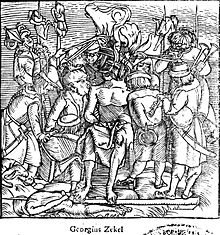György Dózsa

György Dózsa , German Georg Dózsa , ( Hungarian : Dózsa György , Romanian : Gheorghe Doja , Slovak : Juraj Dóža , Croatian : Juraj Doža ; * around 1470 in Dálnok ; † July 20, 1514 in Timisoara ) was a Székely petty nobleman from Transylvania . He excelled as an equestrian captain in the Turkish Wars and was knighted by the Hungarian King Vladislav II . He was the leader of the peasant uprising against the Hungarian magnates, named after him.
Life
Under the weak King Vladislav II , the Hungarian magnates had steadily increased their power. The resulting oppression of the rural poor led to great dissatisfaction. In addition, the ideas of the Reformation began to spread across large parts of Europe . In this tense situation, the new Pope Leo X called for another crusade against the Turks . In 1513, György Dózsa was commissioned by Tamás Bakócz to set up and lead a crusade army. Within a short time, 100,000 so-called Kuruzen , mostly farmers, gathered in several cities , who wanted to escape their difficult and meager life. This met with resistance from the large landowners, who feared the loss of their cheap labor. They also saw a great danger in the arming of the peasants. They brutally suppressed the backward population and refused to provide the crusade army with food. So there was an uprising.
György Dózsa took the lead in the rebellion, which many clergymen also joined. The pastor Lörincz Mészáros became the spiritual leader of the uprising. They demanded equality for all subjects of the King of Hungary and the abolition of the feudal prerogatives of the nobility. In vain was the Pope's bull revoked and the peasants called to return to their villages. Armed bands of peasants roamed the country, pillaging and murdering.
- ... we will ... hang you on the gables of your house gates, have you speared, we will devastate and waste your goods, kill your wives and children.
In a hurry, Johann Zápolya , the prince of Transylvania , raised an army of mercenaries . In this way many of the poorly organized farmers could be defeated. But György Dózsa crossed the Tisza with a large part of the peasant army and invaded the Kreisch area and the Banat . In the summer of 1514 they besieged Timisoara .
On July 15, 1514, Johann Zápolya arrived with his army in front of Timişoara and stood for battle. Initially, the farmers, under Dózsa's leadership, were able to assert themselves against the battle-hardened mercenaries. But when the troops of the Comes of Timisoara, István Báthory intervened, the defeat of the peasants was sealed. The leaders were tortured at Zápolya's orders. György Dózsa, mocked as the “peasant king”, was placed on a red-hot iron chair with a crown and scepter, also red-hot. His body was quartered and displayed in Hungarian cities.
After the uprising was put down, the Hungarian magnates enacted laws that stipulated the serfdom of the peasants for the next few centuries and effectively deprived them of all civil rights.
Historical meaning
While György Dózsa was a rebel, murderer and robber for some, he became a martyr for others . In Hungary today he is revered as a national hero alongside Sándor Petőfi and Lajos Kossuth . Numerous streets as well as a station of the Budapest Metro are named after him. The Hungarian composer Ferenc Erkel dedicated an opera to him. The national poet Sándor Petőfi immortalized Dózsa's death in 1848 in the poem Még kér a nép (The people still ask you, 1847):
- Még kér a nép, most adjatok neki!
- Vagy nem tudjátok, mily szörnyű a nép,
- Ha fölkel és nem kér, de vesz, ragad?
- Nem hallottátok Dózsa György hirét?
- Izzó vastrónon őt elégetétek,
- De szellemét a tűz nem égeté meg,
- Mert az maga tűz; ugy vigyázzatok:
- Ismét pusztíthat e láng rajtatok!
(German translation:
- The people are still asking you to be softened!
- The people become terrible when they rebel.
- When it takes what you refuse by force!
- Lords, have you never heard of Dózsa?
- He was burned on the iron throne.
- Has the commemoration been turned into its opposite?
- His spirit is itself fire! So be careful
- That he doesn't suddenly turn you to ashes. )
The statue of St. Mary in Elisabeth , III. Timișoaras district, today commemorates the place of György Dózsa's death.
Between 1950 and 1991 the successful Budapest sports club Újpest Budapest had the name Dózsas in the club name: Újpesti Dózsa .

Web links
Individual evidence
- ↑ Filozofski facultet Zagreb Katedra za hungarologiju ( Memento of the original from July 15, 2007 in the Internet Archive ) Info: The archive link was inserted automatically and has not yet been checked. Please check the original and archive link according to the instructions and then remove this notice. Magyar motívumok Ödön by Horváth drámáiban
| personal data | |
|---|---|
| SURNAME | Dózsa, György |
| ALTERNATIVE NAMES | Dózsa, Georg (German); Doja, Gheorghe (Romanian); Dóža, Juraj (Slovak); Doža, Juraj (Croatian) |
| BRIEF DESCRIPTION | Leader of the Hungarian peasant uprising |
| DATE OF BIRTH | around 1470 |
| PLACE OF BIRTH | Dálnok |
| DATE OF DEATH | July 20, 1514 |
| Place of death | Timisoara |
